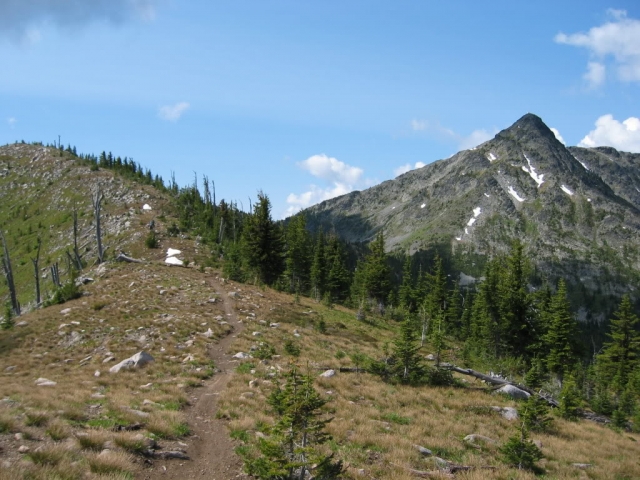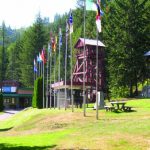TALES AND LEGENDS OF THE MOUNTAIN KINGDOM: Post-boom Rossland and the Building of the Cascade-Rossland Highway
Post-boom Rossland heralded in a quieter, less hurly-burly time for the Mountain Kingdom. Gold production was lessening; after years of gold being relatively close to the surface, as mining continued, tunnels had to get longer and go deeper, upping the cost of production with less output. Copper became an important commodity because it was a byproduct of gold mining found in gold ore. With WWI, copper was used in the manufacturing of munitions. But it didn’t stay lucrative for long; coke was necessary in the smelting of copper, and a big strike in 1917 involving the coke miners in the Crowsnest Pass created a coke shortage, and eventually the Canadian Mining and Smelting Company, Cominco’s precursor, had to suspend its copper smelting operation in Trail. Then WWI ended and the need for copper fell sharply – as did its market price.
While gold was still valuable – it had a fixed market price – the money it brought in was still not enough to cover the cost of mining productions. Mines owned by the CM&S Company were ordered by the company to cease operation in May of 1919. In December 1920, the Josie Mine, AKA Leroi #2, closed its doors. That closure spelled the end of the railroad that ran from Rossland to Northport.
Of course the repercussions of all of these factors were huge. Unemployment in Rossland soared. Alex Pitt was the mayor at this time, and he and his council were actively seeking ways to relieve the problem, as this was the time before welfare and unemployment insurance. In 1920 there was a federal program that offered to pay one third of unemployment costs to municipalities as long as the province and the municipality matched the amount. The program continued in 1921, and Rossland received $223.99 in federal funding, and combined with equal amounts from the province and municipal coffers, the total was $671.97 – to be distributed amongst all of Rossland’s unemployed. At one time, the count of unemployed head of households alone was 50.
What the town needed was a plan. Long had the local government and Board of Trade yearned for a road connecting Rossland with the Boundary region around Christina Lake and Grand Forks. After years of pressuring the provincial government, eventually everyone’s pleas were answered in the form of the province sending out tenders to build six miles of road between Rossland and the Velvet Mine, which was located five miles out of town over the first summit of our local seven summits. Popular thought was that the road would increase traffic into town, decrease the sense of isolation Rossland felt from the rest of the province, and benefit the Velvet Mine, which was still open.
The province announced in August of 1920 that road would be built, and in January 1921, despite the snowy conditions, 100 men were employed at constructing the new “highway.” Alas, not all of the workers were locals, it seems; there were other infrastructure projects going on in the area and apparently some of the crew were brought in from another location near Penticton.
So this plan, which kind of has similarities to other economic stimulus plans of both the past and the present (let’s invest in infrastructure!) wasn’t enough to alleviate Rossland city council’s concern about unemployment. Six miles of road was a nice start, but it wasn’t enough, and it wanted the project to be extended. Also, it didn’t address adequately the problem of local unemployment. Additionally, as the project came to an end in April 1921, it was far from complete. The road was not travelable, requiring a layer of crushed rock to keep it from turning into a muddy quagmire that wouldn’t allow vehicles to traverse it. This meant that the Velvet Mine wouldn’t have the access to and from its premises it needed to continue to operate in a viable way.
After some intense lobbying on the part of the workers, city council, and local MLA Billy Esling, the government announced that it would fund an extension of 15 miles – but only on the Christina Lake end of the proposed road.
This would not do, and Rosslanders were very disgruntled indeed.
“There is not so much as a single settler or shack to be benefitted,” locals declared. Whereas a whole town, sputtering away like a dying old machine, stood to benefit a lot. Prayers were answered in March 1922 when the province announced that it would fund an extension of the road that would see not only the 19km gap between the end of the first six miles and Christina Lake closed, but it would also have the crushed rock layer for that first six miles laid down.
Construction of the route must have been arduous. I have only been as far as the first summit, and just knowing what I know of that stretch, it couldn’t have been a picnic to build (though the views would have been spectacular). Ron Shearer says in his research, “from the first summit the road went down a very steep mountainside to Big Sheep Creek, dropping perhaps 750 metres in about 3 kilometers as the crow flies. Of course the distance by road was much longer. There were a dozen very sharp switchbacks on the road to make it passable by automobile.” The second summit, called the Santa Rosa Summit, was less steep, only rising approximately 900 metres in less than 2km.
What was to be eventually called the Cascade-Rossland Highway–because its other endpoint was in the small hamlet called Cascade, near Christina Lake, which became a ghost town after a devastating fire in 1901–saw its first automobile traffic in November 15, 1922. The vehicle carried a set of inspecting engineers and the trip took 5.5 hours from Cascade to Rossland. Eleven days later, a group of local big wigs made a return trip between Rossland and Christina Lake, and after that some other high profile people made runs that were quite short comparatively, between three hours and twenty minutes and three hours.
Then the road had to close for the winter. And it was still not finished. It needed surfacing with crushed rock, and over the next few years the provincial government spent thousands of dollars putting the “highway” into serviceable condition.
While old Cascade Highway provided only temporary relief to a large problem in Rossland, there have been some pleasant offshoots in the longer term. A small settlement sprang up around Big Sheep Creek, warranting a tiny elementary school and a small post office, and some ranching sprouted up. People still live there now, and there are some holiday cabins, too.
Even today, the old Rossland-Cascade Highway itself is still passable with a 4×4, and it’s a bit of a destination for hiking and mountain biking enthusiasts, bringing in tourists, which was one of the longer terms goals Alex Pitt’s city council had for Rossland in the 1920s . They just had to wait a while longer to see it all come to fruition…
Thank you once more to Ron Shearer, whose research notes were my main source for this article.
























